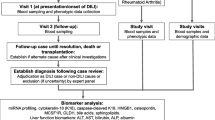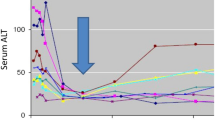Abstract
Background: The most specific indicator of a drug-induced liver injury signal in a clinical trial database is believed to be the occurrence of subjects experiencing drug-associated elevations in both serum ALT and serum total bilirubin (TB) without a significant elevation in serum alkaline phosphatase (ALP). eDISH (evaluation of Drug-Induced Serious Hepatotoxicity) is a recently described tool that organizes liver laboratory data by graphically displaying peak serum ALT and TB levels for each subject, and can also provide direct links to the pertinent clinical and laboratory data for each subject.
Objective: To illustrate the usefulness of the eDISH approach in the presentation of liver safety data by using phase III clinical trial data for rivaroxaban.
Methods: Four randomized, active-controlled studies were conducted worldwide in subjects undergoing elective hip or knee replacement surgery to compare the efficacy and safety of the anticoagulant rivaroxaban, an oral, direct Factor Xa inhibitor, with the low-molecular-weight heparin, enoxaparin. Liver laboratory assessments, including ALT, AST, TB and ALP, were performed frequently during the studies. Data were incorporated into eDISH and linked data for selected subjects were analysed.
Results:In the pooled analysis of the four studies, a total of 12262 subjects (6131 rivaroxaban, 6131 enoxaparin) received at least one dose of study drug and had at least one central and/or local laboratory assessment during the study. A total of 143 (2.33%) rivaroxaban subjects and 223 (3.64%) enoxaparin subjects experienced a peak ALT >3 × upper limit of normal (ULN) but did not experience an elevation of TB >2 × ULN; these subjects are displayed in the right lower quadrant of the eDISH plot, termed the ‘Temple’s Corollary quadrant’. There were ten rivaroxaban and ten enoxaparin subjects with a peak ALT >3 × ULN and a peak TB >2 × ULN; these subjects were displayed in the right upper quadrant of the eDISH plot, termed the ‘Hy’s Law quadrant’. eDISH allowed efficient examination of the relevant data for each of these subjects.
Conclusions:The eDISH approach is an efficient and effective way to organize and examine large liver safety databases for randomized controlled clinical trials. It greatly facilitates a systematic and transparent examination of the relevant liver safety laboratory data. We believe eDISH should become a standard approach for assessing and studying liver safety issues in clinical trials.





Similar content being viewed by others
References
Senior JR. Monitoring for hepatoxicity: what is the predictive value of liver “function” tests? Clin Pharmacol Ther 2009 Mar; 85(3): 331–4
FDA. Guidance for industry. Drug-induced livery injury: premarketing clinical evaluation. July 2009 [online]. Available from URL: http://www.fda.gov/downloads/Drugs/GuidanceComplianceRegulatoryInformation/Guidances/UCM174090.pdf [Accessed 2009 Dec 17]
Watkins PB, Seligman PJ, Pears JS, et al. Using controlled clinical trials to learn more about acute drug-induced livery injury. Hepatology 2008 Nov; 48(5): 1680–9
Guo T, Gelperin K, Senior J. A tool to help you decide (detect potentially serious liver injury). March 2008 [online]. Available from URL: http://www.fda.gov/downloads/Drugs/ScienceResearch/ResearchAreas/ucm076777.pdf [Accessed 2009 Dec 17]
Eriksson BI, Borris LC, Friedman RJ, et al. Rivaroxaban versus enoxaparin for thromboprophylaxis after hip arthroplasty. N Engl J Med 2008 Jun; 358(26): 2765–75
Lassen MR, Ageno W, Borris LC, et al. Rivaroxaban versus enoxaparin for thromboprophylaxis after total knee arthroplasty. N Engl J Med 2008 Jun; 358(26): 2776–86
Kakkar AK, Brenner B, Dahl OE, et al. Extended duration rivaroxaban versus short-term enoxaparin for the prevention of venous thromboembolism after total hip arthro-plasty: a double-blind, randomized controlled trial. Lancet 2008 Jul; 372(9632): 31–9
Turpie AGG, Lassen MR, Davidson BL, et al. Rivaroxaban versus enoxaparin for thromboprophylaxis after total knee arthroplasty (RECORD 4): a randomized trial. Lancet 2009 May; 373(9676): 1673–80
Zimmerman HJ. The spectrum of hepatotoxicity (Kober lecture). Perspect Biol Med 1968 Autumn; 12(1): 135–61
Kaplowitz N. Idiosyncratic drug hepatotoxicity. Nat Rev Drug Discov 2005 Jun; 4(6): 489–99
Dukes Jr GE, Sanders SW, Russo Jr J, et al. Transaminase elevations in patients receiving bovine or porcine heparin. Ann Intern Med 1984 May; 100(5): 646–50
Guevara A, Labarca J, González-Martin G. Heparin-induced transaminase elevations: a prospective study. Int J Clin Pharmacol Ther Toxicol 1993 Mar; 31(3): 137–41
Carlson MK, Gleason PP, Sen S. Elevation of hepatic transaminases after enoxaparin use: case report and review of unfractionated and low-molecular weight heparin-induced hepatotoxicity. Pharmacotherapy 2001 Jan; 21(1): 108–13
Andrade RJ, Lucena MI, Fernández MC, et al. Drug-induced liver injury: an analysis of 461 incidences submitted to the Spanish registry over a 10-year period. Gastro-enterology 2005 Aug; 129(2): 512–21
Critical Path Institute. Predictive Safety Testing Consortium (PSTC) [online]. Available from URL: http://www.c-path.org/pstc.cfm [Accessed 2009 Dec 17]
Acknowledgements
Bayer Schering Pharma AG and Johnson & Johnson Pharmaceutical Research & Development, LLC, provided funding for the RECORD studies. The sponsors were also involved in the design and conduct of the studies (including the collection, management, analysis and interpretation of the data). Dr Watkins has served as a compensated consultant for Johnson & Johnson Pharmaceutical Research & Development, LLC, but received no compensation for his lead role in preparing this manuscript. Dr Desai and Dr Peters are employees of Johnson and Johnson Pharmaceutical Research & Development, LLC. Dr Berkowitz is an employee of Bayer HealthCare Pharmaceuticals Inc. Dr Horsmans has served as a consultant for Bayer HealthCare and Johnson & Johnson Pharmaceuticals. Dr Larrey has been a consultant for analysing rivaroxaban liver safety in the phase III trials. Dr Maddrey has consulted with Johnson & Johnson and Bayer regarding the hepatic safety of rivaroxaban. The authors wish to thank a number of individuals for their help with the collection, preparation and review of the data discussed in this manuscript; specifically, Sabine Dittmar, Martin Homering, Emanuel Lohrmann, Eugene Schiff, and Torsten Westermeier. The authors would also like to acknowledge Seamus McMillan of Chameleon Communications International, who provided editorial support with funding from Bayer Schering Pharma AG and Johnson & Johnson Pharmaceutical Research & Development, LLC.
Author information
Authors and Affiliations
Corresponding author
Rights and permissions
About this article
Cite this article
Watkins, P.B., Desai, M., Berkowitz, S.D. et al. Evaluation of Drug-Induced Serious Hepatotoxicity (eDISH). Drug-Safety 34, 243–252 (2011). https://doi.org/10.2165/11586600-000000000-00000
Published:
Issue Date:
DOI: https://doi.org/10.2165/11586600-000000000-00000




